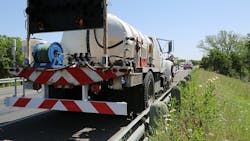Do not mess with Texas wildflowers
Many may not realize what an attraction the spring wildflower bloom is in Texas—or even that the state has such an impressive wildflower crop. But each spring, throngs of those in the know flock all over the state to get a glimpse of fields swathed in bright colors like flame orange, yellow, blue and pink.
But these fields also generate a lot of green—in the form of tourism dollars pouring into the state’s economy. This is something not lost on Dennis Markwardt, maintenance field support manager with the Texas Department of Transportation (TxDOT), based in Austin.
“The wildflower program brings in thousands and thousands of tourists every year,” Markwardt says. “If you go out to the Hill Country and try to get a hotel on a weekend during wildflower season, you won’t find any available. It draws people from all across the state and country.”
Flowers provide beauty and serve a purpose
The good majority of the wildflowers blossom alongside the state’s 1 million miles of roads and highways and 800,000 acres of rights-of-way. What this means is Markwardt is the caretaker of one of the largest wildflower crops in the world.
The wildflowers aren’t there only to provide beauty—they also serve a practical purpose as a desirable groundcover. Their dense presence helps stabilize the soil and fight off other vegetation that is less than desirable.
Of course, it’s not just beautiful wildflowers that call Texas roadsides home. The state’s sheer size and diverse conditions also mean there’s a multitude of undesirable species of trees, brush and weeds constantly trying to replace the wildflowers, which would ruin the roadside aesthetics and create potential safety hazards for motorists.
For example, in south Texas, it’s mesquite and huisache. In the central part of the state, there’s cedar, oak and all types of broadleaves and brush. In the east, it’s Johnsongrass. The trick comes in treating the tough undesirable plants, while maintaining the delicate desirable wildflowers. And that’s where herbicides play a significant role.
Herbicides take down brush while leaving the flowers
“The first thing that we look for in a herbicide at TxDOT is safety,” Markwardt says. “But beyond that, we need to make sure the product is effective and that it fits into our program and into our long-term goals.”
Capstone specialty herbicide is one of those herbicides. And using it as the foundation of TxDOT’s side trim treatment has proven to be very effective.
Mechanical cutting can be dangerous, time-consuming and expensive work, making the use of herbicides a good alternative in many situations. Using a herbicide to chemically side-trim a tree controls the parts of the tree that are presenting hazards to nearby roadside access, motorist safety or visibility. When used correctly, certain herbicides have demonstrated their ability to effectively “prune back” the treated limbs.
TxDOT realizes the advantages of a balanced approach between herbicide and mechanical treatments. And that balance helps keep its roadsides safe and full of wildflowers every spring, and the tourists coming back.
“Herbicides should play a crucial role in all vegetation management programs,” Markwardt says. “To me, without the use of herbicides, I don’t know how anybody could afford to implement a vegetation management program.”
